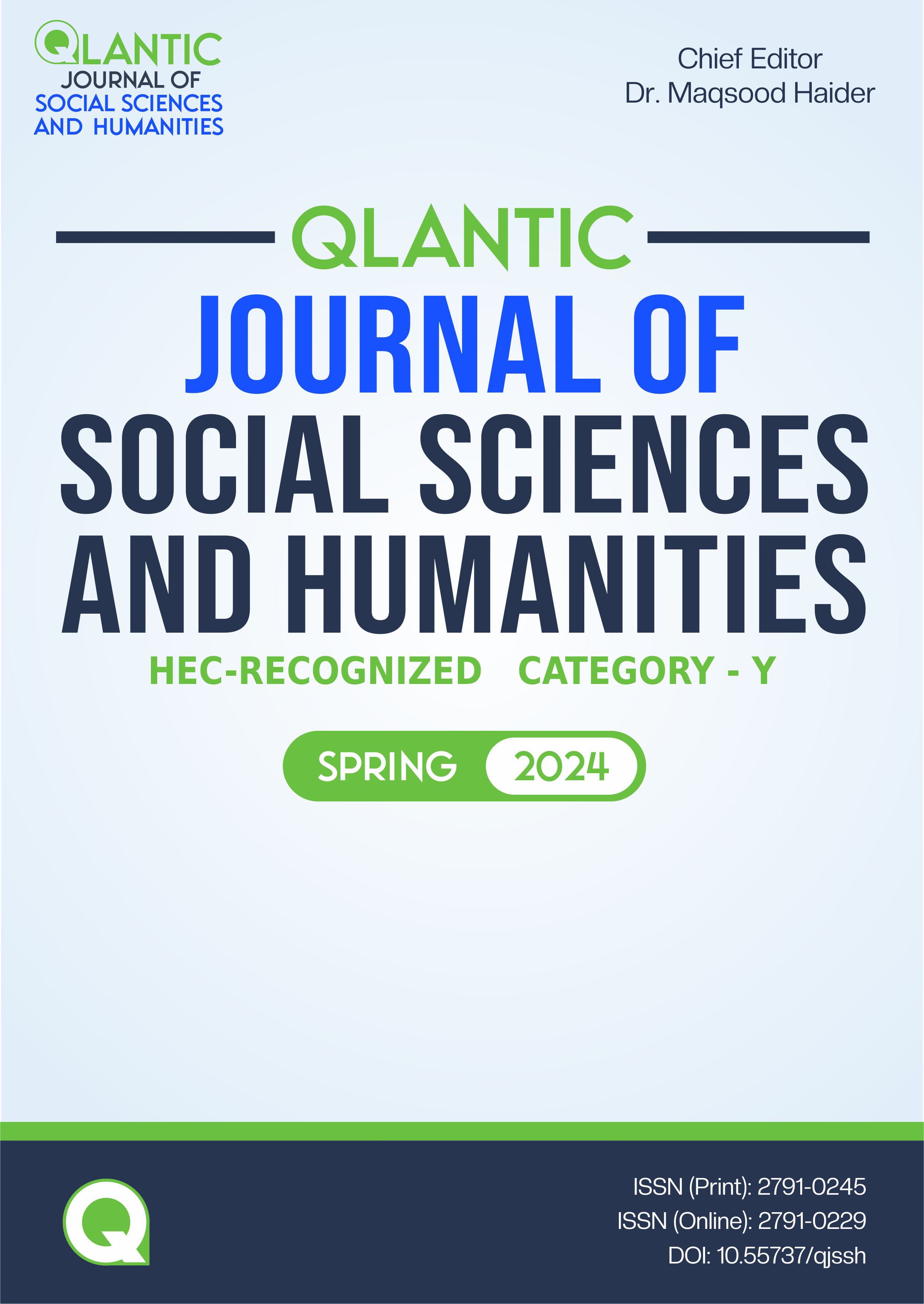Causes of Deterioration of Elementary Education and Potential Solutions
DOI:
https://doi.org/10.55737/qjssh.5011978450Keywords:
Causes of Deterioration, Potential Solutions, Teachers, Students, Elementary LevelAbstract
This research study aimed to find out the causes of the deterioration of elementary education and potential solutions perceived by teachers. The major objective of this study was to examine the causes of deterioration in elementary education and potential solutions perceived by teachers. All male and female elementary teachers in both public and private schools in the district Muzaffargarh were the population. The sample consisted of 274 school teachers (150 male and 124 female), who were selected through a stratified sampling technique. For data collection, a 40-item self-structured questionnaire was designed for teachers. Findings showed that causes of deterioration of Elementary education as perceived by teachers include insufficient resources, inadequate funding, large class sizes, lack of teacher training, outdated curriculum, and lack of parental involvement. The solutions included increased funding for education, reducing class sizes, providing opportunities for professional development for teachers, updating the curriculum to be more relevant and engaging, improving access to resources and technology, parental involvement, and fostering stronger collaboration between teachers, parents, and administration.
References
Akbar, R. A. (2012). Mind the Fact: Teaching Science without Practical as Body without Soul. Journal of Elementary Education, 22(1), 1–7. https://pu.edu.pk/images/journal/JEE/PDF-Files/1_Rafaqat-1_2012JEE_Vol_22_no_1.pdf
Amir, S., Sharf, N., & Khan, R. A. (2020). Pakistan’s education system: An analysis of education policies and drawbacks. Electronic Research Journal of Social Sciences and Humanities, 2(1), 2-11. https://www.eresearchjournal.com/wp-content/uploads/2020/07/2.-Pakistans-Education-System.pdf
Ashraf, I., Ashraf, F., Saeed, I., Gulzar, H., Shah, K., Azhar, N., Bukhari, S. R., Ilyas, T., & Anam, W. (2015). Reasons for Low Performance of Teachers: A Study of Government Schools Operating in Bahawalpur City, Pakistan. International Journal of Academic Research in Progressive Education and Development, 4(2). https://doi.org/10.6007/ijarped/v4-i2/1764
Asif, M. F., Safdar, H., & Ali, S. (2020). Factors affecting the performance of school students: A case study of Bahawalpur. Ilkogretim Online, 19(3), 3650-3660. https://www.bibliomed.org/?mno=125052
Barron, B., & Darling-Hammond, L. (2008). Teaching for Meaningful Learning: A Review of Research on Inquiry-Based and Cooperative Learning. Book Excerpt. George Lucas Educational Foundation.
Basher, Z., Hussain, S., & Javed, T. (2012). The Effectiveness of Co-curricular Activities on Academic Achievements of Elementary School Students in District Abbottabad Pakistan - A Case Study. Developing Country Studies, 2(5), 53–55.
Bashiruddin, A., & Qayyum, R. (2014). Teachers of English in Pakistan: Profile and recommendations. NUML Journal of Critical Inquiry, 12(1), 1–19.
Darling-Hammond, L. (2018). "Motivation and Inspiration in Elementary Education: The Role of Clarity of Goals." Elementary Education Journal, 12(4), 123–137.
Ghazi, S. R., Shahzada, G., Tariq, M., & Khan, A. Q. (2013). Types and Causes of Students’ Disruptive Behavior in Classroom at Secondary Level in Khyber Pakhtunkhwa, Pakistan. American Journal of Educational Research, 1(9), 350–354. https://doi.org/10.12691/education-1-9-1
Global, E. F. A. (2010). Education for All by 2015: Will we make it? Joining the Conversation: Writing in College and Beyond, 291.
Hanushek, E. A., & Woessmann, L. (2023). The knowledge capital of nations: Education and the economics of growth. MIT Press.
Hati, S. T. (2021). Social Studies Education Responding to the Challenges of the 21st Century: A Critique of Learning Practices in Elementary Education. Jurnal Basicedu, 5(6), 5573–5582. https://doi.org/10.31004/basicedu.v5i6.1718
Mahmood, S., Fatima, Q., & Lodhi, H. (2022). Overcrowded Classroom Management Strategies Used by Teachers and Their Challenges at Primary School Level in Pakistan. Pakistan Languages and Humanities Review, 6(2), 935–949. http://doi.org/10.47205/plhr.2022(6-II)79
Parveen, M. I., & Shah, J. (2012). Developing a Strategy for School Improvement. International Journal of Asian Social Science, 2(2), 81-87.
Rahman, S., Munam, A. M., Hossain, A., Hossain, A. S. M. D., & Bhuiya, R. A. (2023). Socioeconomic factors affecting the academic performance of private university students in Bangladesh: a cross-sectional bivariate and multivariate analysis. SN Social Sciences, 3(2). https://doi.org/10.1007/s43545-023-00614-w
Rashid, K., & Mukhtar, S. (2012). Education in Pakistan: Problems and their solutions. International journal of academic research in business and social sciences, 2(11), 332–343.
Saleem, A., Muhammad, Y., & Masood, S. (2020). Support Needs of Novice Public-School Teachers for Effective Management of Elementary Level Classrooms in Lahore. Pakistan Social Sciences Review, 4(III), 682–697. https://doi.org/10.35484/pssr.2020(4-iii)48
Sarkodie, N. A., Asare, A., & Asare, D. (2020). Factors Influencing Students’ Choice of Tertiary Education. ADRRI Journal (Multidisciplinary), 28(11(5), 58-92. https://doi.org/10.55058/adrrij.v28i11(5).518
Sayan, F., Fida, & Hussain. (2012). Pakistan's existing education system. www.eric.articles/pak/edu
Shahzad, M. N., Sajjad, S., Ahmed, M. A., & Asghar, Z. (2013). The Role of “Radical Change” in Medium of Instruction and Its Impact on Learning. Journal of Language Teaching and Research, 4(1). https://doi.org/10.4304/jltr.4.1.36-44
Tunio, M. N., Arain, N. R., & Tunio, S. P. (2013). Assessment of Computer Literacy at Elementary Education Level in Rural Areas of Sindh (Pakistan). International Journal of Emerging Science and Engineering, 1(7), 13-15. https://citeseerx.ist.psu.edu/document?repid=rep1&type=pdf&doi=649ed9d77a2ed90a5def0d619ae66db8e28e47c7
Umer, S., & Siddiqui, J. A. (2013). Improving Trends of Teaching Methods Used in the Concept Schools of Karachi: An Evaluative Study. Educational Research International, 2(2), 146-154. http://www.erint.savap.org.pk/PDF/Vol.2(2)/ERInt.2013(2.2-18).pdf
UNESCO. (2015). Education 2030: Incheon Declaration and Framework for Action for the implementation of Sustainable Development Goal 4. UNESCO.
Vygotsky, L. S., & Cole, M. (1978). Mind in society: Development of higher psychological processes. Harvard University Press.
Yang, L. (2011). Orientation and Functions of Library in Quality Education of College. International Education Studies, 4(2). https://doi.org/10.5539/ies.v4n2p195
Zakar, P. D. M. Z., Qureshi, D. S., Ullah, D. R., Zakar, D. R., Aqil, N., & Manawar, D. R. (2020). Universal Primary Education in Pakistan: constraints and challenges. South Asian Studies, 28(2), 427-444. http://111.68.103.26/journals/index.php/IJSAS/article/viewFile/2898/1142
Published
Issue
Section
License
Copyright (c) 2024 Qlantic Journal of Social Sciences and Humanities

This work is licensed under a Creative Commons Attribution-NonCommercial 4.0 International License.





